Art in a Complex World
In Sweet Remembrance at Sweet Briar College
On Wednesday, September 3, 2014, Sweet Briar College in Virginia was put on lockdown. No one was allowed to leave and no one was allowed to enter the campus for over an hour. This was the result of a threatening phone call made to the college by an anonymous caller likely motivated by a racially charged incident on the campus the previous week. The caller said, “We want justice. Who is the white girl that did this? Ferguson and now this. Hands up! Don’t shoot! We’re coming up there. We want justice.”
The racially charged incident that sparked this alarming phone call was provoked by a production my theatre company produced for the college. We set out to provoke but never imagined or desired a threatening phone call, a campus lockdown, and eventually a first year African American student leaving the college because of the fallout over a racially charged act of expression. This is where we found ourselves, though, and now I am working through questions I have about what our role as artists is in situations when our work provokes beyond sparking conversations in the lobby and on the drive home from the theatre.
Endstation Theatre Company is located in Central Virginia and I have been serving as its artistic director since its founding in 2006. We are a small organization that primarily serves the greater Lynchburg area. Since 2007 we have been producing work as the resident theatre company of Sweet Briar College. Sweet Briar is a small, private women’s college that rests on 3,250 acres of picturesque land in the Blue Ridge Mountains.
The focus of our work from the company’s inception has been the specific region where we reside. In our early years we used the beauty of the campus as our backdrop for site-specific outdoor work, and our indoor work comprised work we felt spoke to our region either through aesthetic or theatrical circumstance. In the last couple of years we have refined our mission to be completely community centered. It reads: To strengthen our community through the theatrical exploration of its people, its history, and its landscape.
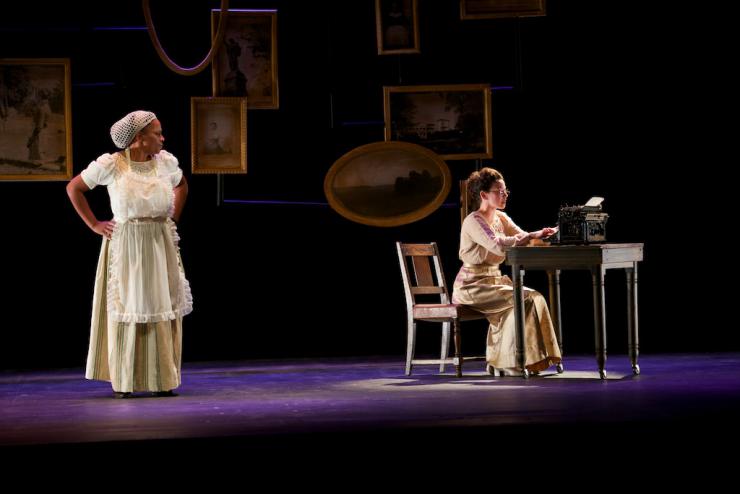
Left to right: Mauresa Guelzo, Makeda Payne
As a part of this, we are dedicated to producing one original new work written specifically for this community each year, and this year we produced In Sweet Remembrance by Tearrance Chisholm, an MFA candidate at Catholic University in Washington, DC. Sweet Briar College and the college’s former President, Jo Ellen Parker, commissioned the play. The play was developed over three years of extensive research by Tearrance and a series of public readings produced by Endstation. Tearrance said of the play, “My goals for the piece were to initiate a dialogue that would begin to unearth some of the issues concerning minority students and staffing. I hoped the play would be a bridge into addressing the amount of diversity on campus.”
The college’s relationship to race is complex because the college rests on the land of a former plantation and the owners of the plantation owned slaves prior to emancipation. When the college was founded in 1901, its charter read “for white women.” The college later changed the charter and in 1966 admitted its first African American student, Marshalyn Yeargin. Even still, the college’s identity is deeply rooted in the past. One of the primary icons of the college is Daisy, the young, white teenage daughter of the original plantation owners. The college was founded in her memory (she passed away at the age of sixteen). The college’s identity, in other words, is deeply tied to its plantation past.
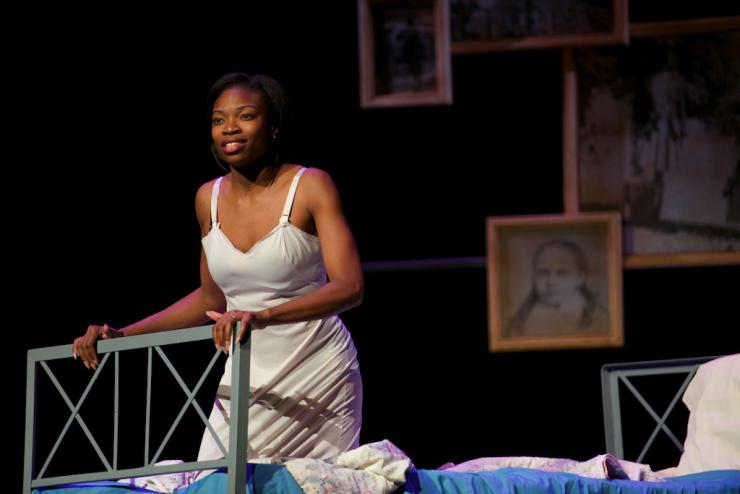
President Parker wanted us to tackle this racial-identity problem through theatrical material. The hope was to generate conversation and use the play as a means of helping the college deal with its complex relationship to race. The play was one of many actions taken by President Parker over her time at Sweet Briar to create open dialogue about race. She drew attention to the slave cemetery on the college grounds and an original slave quarters still standing near the President’s house (the original plantation house), highlighting them as a part of the school’s history instead of ignoring them as had been done in the past. She also talked with frequency at public events about African American figures that had been a major part of the college’s history. President Parker wanted transparency about both the positive and negative relationship the college and its land have had with its black community.
In many ways I had been naïve. I did not envision what was to occur, and yet I think it was important to plan for strong student reactions, whether they happened or not. If we had opened this dialogue, then perhaps we could have opened the door to possible collaborations in how to deal with any student reaction that might have occurred.
Tearrance Chisholm’s approach with this complex task of writing a work that tackled the President’s goals was to create a central character that could go on a journey that would address both the positive and the negative of Sweet Briar’s racial past. He devised a very savvy convention. His central character was Dr. Diana Singer, a fictional character who was the first African American tenure-track professor at the college. This character is fictional because the college has not yet had an African American tenure-track professor. Tearrance also made Diana unwilling to embrace this historical achievement. She simply wants to be a professor and throughout the piece fights being pigeonholed as a black professor. The work is a memory play, and as Diana works to avoid her role as the first African American tenure-track professor, she cannot escape the past that surrounds her on this historic campus. She ultimately has to own her part in the Sweet Briar story. Diana’s journey allowed us to portray a college trying to move into the future, but at the same time we were able to examine its complex and not always flattering past.
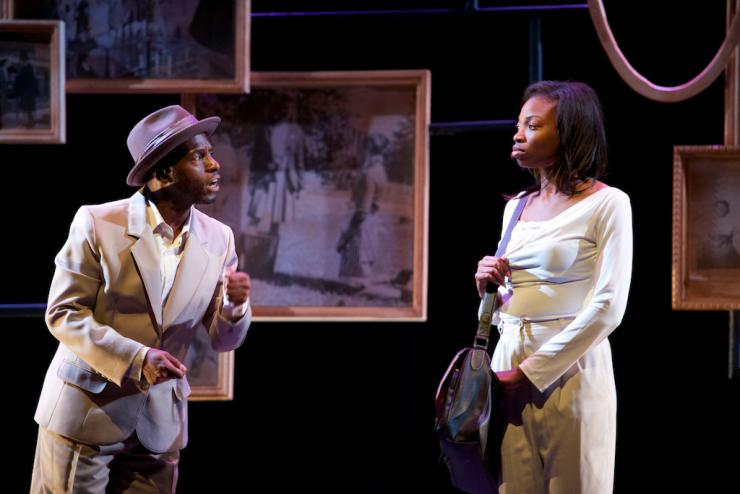
The opening night of the show was performed for the entire freshmen class as a part of their orientation week. Along with the performance was an organized talkback with the students, our artists, a select group of professors, and Dr. Marshalyn Yeargin-Allsopp, the first black graduate of the college. The talkback was pleasant; there were a few moments of discussion that leaned towards in-depth dialogue, but on the whole it was uneventful. It was the next morning that things got complex.
The next morning in one of the freshmen dorms, a student placed signs above water fountains and on some doors that read “Colored” and “White Only.” This rattled a campus community that was already afraid of racial insensitivity. It should be noted that a few weeks earlier President Parker left for Pittsburgh where she took on the presidency of the Carnegie Museums. She was no longer the champion of the production. There was an interim college president who inherited our production and its adjoining activity. The college was very supportive of the production, but the dynamics of engagement with the play had changed.
The incident made it into the local media and became water-cooler conversation throughout the Lynchburg community. The coverage of the events briefly referenced Tearrance’s play. The college was doing an incredible thing by producing a piece of art to initiate dialogue. This part of Sweet Briar’s story would have been a wonderful one to tell. Their engagement was very brave, and I wish that the media had not simply grabbed onto telling the story of the aftermath. The majority of the media focus was on finding the student responsible and the college’s response to the incident.
Meanwhile, we continued to perform the play through the weekend. In the production were four Sweet Briar students, working alongside our professional actors. These students were really our primary window into what was happening on campus. They were clearly upset. One of the students, a young black woman from New Orleans, was the most unnerved. The issues addressed by the play and the events happening around her dealt directly with her own identity at the college. We did our best to talk this out with her. We discussed what her role as an artist was in this moment of tension. As we discussed this, I questioned my own role as well.
Understandably, the college’s focus largely turned to the PR concerns and the larger institutional issues associated with this occurrence. The result was that our production and the students involved were no longer a part of the dialogue. I understand the priorities of the college. At the same time, as an artist, I really felt a need to engage with the community impacted by our work. We create art to provoke. It is our job. At the same time the college needs to protect its students and its community. My desire as an artist and the obligations of the institution were colliding.
A friend of mine who used to work at Cornerstone Theater Company in Los Angeles got me in contact with Michael John Garcés, their artistic director. Cornerstone’s community-engaged work is some of the best in the country. After my conversation with Michael, I walked away with something very valuable. Transparency, open communication, and response-planning are key when doing socially provocative work. Michael shared a few stories with me, but the overarching theme was that open dialogue and discussion with your creative partners in this kind of work are essential. When President Parker left the college, a hole in our planning was exposed. We had simply followed her lead to that point. When she left, we should have immediately opened a dialogue with other members of the administration about the possible issues that might have arisen from the production. In fact, we should have done this with President Parker from the start. In many ways I had been naïve. I did not envision what was to occur, and yet I think it was important to plan for strong student reactions, whether they happened or not. If we had opened this dialogue, then perhaps we could have opened the door to possible collaborations in how to deal with any student reaction that might have occurred.
It was widely assumed by many that the student who placed the signs over the water fountains was white and that this was an act of overt anti-black racism. In the end, it turned out that the student who put the labels up in the freshmen dorm was African American. Her response to the play was, perhaps, misguided but it was an attempt to engage in a conversation with the play and the community that produced it. In the end she withdrew from the college. I walked away feeling helpless, because whether the reality or not, I felt that I had failed her. This piece set out to create an environment of inclusion and somehow she got pushed away.
In the future, I am changing how our theatre company partners on projects that tackle socially complex issues. We need to have a plan of action in place from the beginning, as well as a clear understanding of what our role is as the creators of the play. This is important not only at the beginning of the project but most importantly at the conclusion. It was not my place to step into the middle of the college’s response, but I do think there was an opportunity for us to have been of service. If we had, from the onset, set up a plan of response, I think both the work, the student, and the college would have benefitted, because with the proper planning and dialogue this could have been a different story: a story of how art provoked conversation and took a step towards changing the way a community talks about race.
***






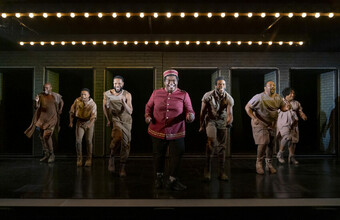

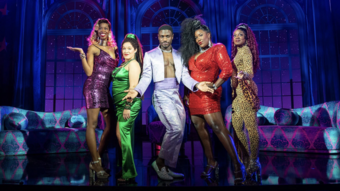



Comments
The article is just the start of the conversation—we want to know what you think about this subject, too! HowlRound is a space for knowledge-sharing, and we welcome spirited, thoughtful, and on-topic dialogue. Find our full comments policy here
Thank you for sharing your story. What do you think this student was frustrated about? I'm not fully clear what was done in the script for such a reaction.
Sydney, I am not actually sure the student was frustrated. I think it was a form of personal expression in response. Almost like a conversation. The show was a journey through the college's history with its black population. I think the student was making a historical reference (Jim Crow) in a modern context. I think the style of the show inspired this. The student left the school over the fall out, as I understand it. I never met the student though. When the incident occurred, we were not included in the response. Having that said, I am not privy to all the details of the student and her intentions. This is largely my impression.